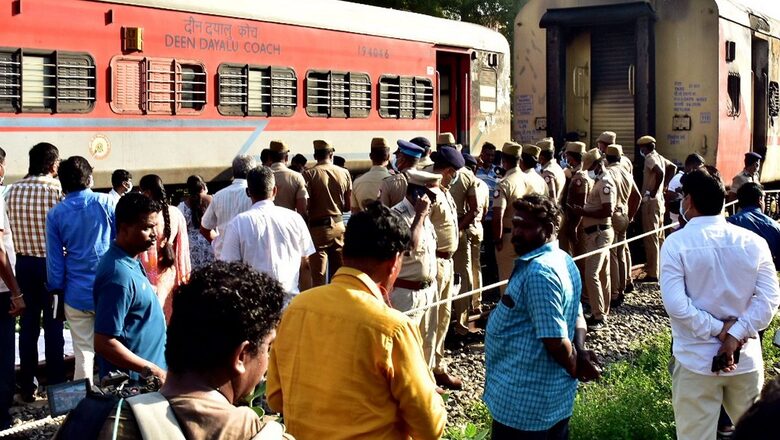
views
It has been reported that at least 10 passengers were charred to death, beyond recognition, when fire engulfed a stationary train compartment in the wee hours on August 26. The privately booked coach was to ferry 65 UP pilgrims back from Rameswaram to Lucknow. 20 others received varying degrees of burn injuries. A few passengers brought them to safety by forcing them out by breaking open windows and doors bolted from the inside. It took three hours for the fire to be put out by fire tenders.
I humbly posit Madurai fire accident was waiting to happen. And as we will see later, the reasons are legion.
God Averted A Bigger Disaster
Mercifully, the fire broke out in a stationary coach. Had it happened on a moving train, the casualty would have been much higher as in a moving train, fire in a coach spread fast and in no time engulfs coaches in the vicinity. I will return to this theme later.
Passing the Buck
Southern Railway has passed the buck. The fire has been attributed to the bursting of a cooking gas cylinder smuggled by passengers. The moot point is who, how, when and where boarded the cylinder on the ill-fated coach that commenced its journey on August 17. Government Railway Police (GRP) has lodged an FIR against the private tour operator for smuggling the gas cylinder. It is over to the Commissioner of Railway Safety (CRS) to identify the cause of the accident.
The case stands closed, till the next fire accident.
Lessons Unlearnt from Past Fire Accidents
The Madurai fire accident is neither the first nor last on the Indian Railways (IR) network. Also, like past fire accidents, the IR has already closed the Madurai accident chapter without root cause analysis. I say what I say because the IR has witnessed a spate of railway fire accidents over decades. The reasons for fire accidents are all well known but no action has been taken to drill down root causes and develop “zero tolerance” for fire accidents.
Bird’s Eye View of IR Fire Accidents
For existential reasons, the author is a chronicler of IR fire accidents. Interestingly, the biggest learning of the author from the IR fire accidents is that they are largely a post-independence phenomenon. Despite microscopic examination, I could not lay hands on a single serious fire accident between circa 1901-1954.
Genesis of IR Fire Accidents
The first recorded fire accident on a moving train that I had identified happened on March 31, 1954, when explosives carried on a passenger train detonated near Gorakhpur in UP, killing at least 32 and injuring 50. Had IR learnt from the root cause of this accident, future similar accidents would have been averted. It did not happen. What should have stopped with 1954 continued to repeat with alarming frequency in decades to come.
Cancer Metastasis
Over decades, the cancer of fire accidents has metastasized, but the IR’s deep antipathy for doing root cause analysis and stopping fire accidents is visible to the naked eye. Fire accidents on IR are avoidable and stoppable. Moving beyond 1954, it has witnessed fire accidents at regular intervals, and I am chronicling a few representative cases. The list is neither complete nor comprehensive.
In a repeat of 1954, on August 19, 1957, a coach carrying crackers exploded at Katpadi in Tamil Nadu, killing five and injuring 12. Mercifully, for the next 17 years (1960s and early 1970s), no major fire accident was reported, though there were multiple near misses.
The next fire accident on September 12, 1974, involving Sealdah-Samastipur Fast Passenger in the Danapur division of Eastern Railway, with no major injury or death, should have alarmed the Railways. Near misses are worse than actual accidents and they provide an opportunity for connective action. Had the IR done a root cause analysis and learnt vital lessons from the near miss of 1974, the worst fire accident of Indian Railways, 16 years later in 1990, in the same Danapur Railway division would have been prevented altogether.
This did not happen.
1985 and 1990: Worst Years of Fire Accidents Post-Independence
In 1985, Indian Railways suffered its worst fire accident in its history when on February 23, at Rajnandangaon in MP, a fire in two bogies of an express train charred 50 passengers to death with hundreds severely injured. But the worst was yet to come.
The ink on the ignominy of the 1985 fire accident had not even dried that in 1990, the IR was turned serial killer in three totally avoidable fire accidents. The worst happened on May 16, 1990, when the passenger shuttle Buxar-Arrah-Patna-Mokama caught fire at Patna’s Rajendra Nagar. The fire spread like a wildfire consuming three coaches. 74 passengers were charred to death and more than 400 sustained severe burn injuries.
Closely thereafter, on June 6, 1990, 35 passengers were killed in a train fire accident at Gollaguda in Andhra Pradesh. In October same year, at least 40 people were burnt to death in a train fire accident on a passenger train, at Cherlapalli on the city outskirts in Andhra Pradesh.
To sum up, 1990 was the worst year when three train fire accidents happened, one worse than the other, charring at least 150 passengers to death and badly injuring more than 500.
Alas! All three accidents could have been avoided.
History Repeats
History repeated in 1994, when on October 26, in an early morning tragedy, 8001 DN Mumbai Howrah Mail caught fire, killing 27 passengers. The accident happened between Lotapahar and Chakradharpur railway stations of Southeastern Railway. The fire was reported to have been caused by a kerosene stove belonging to a vendor. The accident death estimate was reportedly, grossly underestimated, as the second-class coach was jampacked and the accident occurred in the wee hours.
21st Century Begins with Bang
In Ludhiana, on May 15, 2003, at least 38 people were charred to death and 50 injured when the Mumbai-Amritsar Golden Temple Express (Frontier Mail) caught fire around 4 AM. Three coaches — the S4, S3 and S5 — were completely destroyed and another partially damaged in the fire. The causative factor reported for the wee hour accident was the same again — a bursting of a gas or kerosene stove.
Come 2009, and on the same day, when the railway minister in his budget speech touted the safety record of railways, many coaches of Chennai bound Coromandel Express post derailment caught fire. The reported death and injury numbers were 16 dead and 161 injured.
Decade of 2010 Proved Worse
Each year, between 2011 and 2014, recorded at least one major fire accident and many near misses. In 2011, in a fire accident in two coaches (B-1 AC coach and then spread to B-2 AC coach) of Howrah Dehradun Express, at least seven, including children, were charred to death, after a fire broke out in Jharkhand’s Giridih district in wee hours.
In 2012, a mystery fire broke out in a sleeper class coach of Chennai-bound Tamil Nadu Express on Monday morning, killing 32 passengers and injuring 25 others in one of the worst mishaps in the region. The then Railway Minister was quick to cry foul, suggesting sabotage, but the inferno on wheels (Superfast Express train from Delhi to Chennai was travelling at a speed of over 100 km per hour when the tragedy struck the train a little after 4 AM) was finally attributed to short circuit in one of the toilets of the ill-fated coach.
On December 28, 2013, an air-conditioned coach of the Bangalore-Nanded Express caught fire, killing 28 with score left nursing burn injuries. Shortly thereafter, in less than three weeks, in January 2014, a fire in three sleeper coaches of the Dehradun Express killed nine people and injured many. The tragedy occurred at 2.35 AM between Dahanu Road and Gholwad stations on the Mumbai-Surat section.
Fortunately, the years 2015 to 2017 were one of a lull when no major fire accident was reported, but in 2018, on May 6, a major fire was averted when locomotive WAP4 hauling 12810 Howrah Mumbai Mail caught fire killing the assistant loco pilot and severely injuring the loco pilot. Mercifully, the fire did not spread to coaches. The accident happened near Wardha.
The year 2019 again gave an opportunity to the Indian Railways to learn the lesson from avoidable fire accidents. But no learning was done and applied. It happened on August 29 with two coaches of train number 12723 Hyderabad NDLS Telangana Express catching fire between Asaoti and Ballabgarh stations in Haryana at 7:43 AM. Apparently, in the fire accident that began as heavy smoke and flames from the wheels of the ninth coach from the rear end, all passengers were saved.
2020s: Fire Accident Near Misses Abound
Despite plentiful fire accidents in preceding decades, including the worst decades of the nineties and the decade just gone by, no lessons were learnt by the IR and fire accidents have continued unabated in the current decade.
In another unfortunate early morning mishap, on January 21, 2021, the parcel coach of Malabar Express caught fire and no casualties were reported. The fire was first noticed by the passengers of the train at about 7.47 AM and they immediately pulled the chain and informed the Railway authorities thereby saving from bigger damage to life. Interestingly, the fire was ignited by two motorbikes inside the front luggage van.
On November 18, 2022, a fire broke out inside the pantry car of the Navajivan Express. Railway officials brought the train to a halt at AP’s Gudur Junction, doused it and prevented a major accident. Earlier, a similar fire accident had started from a parcel van of Mumbai-bound Shalimar Express on November 5, 2022. Fortunately, it did not spread and there were no casualties.
The year 2023 has seen the trinity of fire accidents. One, on June 23, 2023, a coach of Lokmanya Tilak Express from Chennai to Mumbai caught fire. Instead of learning the lesson, Southern Railway was quick to issue an official rejoinder that it was not a fire accident, forgetting that there is no smoke without fire. Two, on July 7, 2023, seven coaches of the Howrah-Secunderabad Falaknuma Express caught fire near Telangana’s Nalgonda. Mercifully, no one died or sustained burn injuries. Three is the latest Madurai accident with nine confirmed deaths and 10 injuries.
When will the IR learn?
As the numbers speak, since independence, at least 500 passengers have been killed in train fire accidents and 1000s have sustained burn injuries. As it is these are a number too many, but the actual number of deaths reported is highly inexact and likely to be much higher as victim coaches of most fire accidents have been ordinary second-class and sleeper coaches and most accidents have occurred in wee hours. Also, for the uninitiated the burn injuries are fatal, difficult to heal and often turn septic leading to limb amputations.
The question that troubles my three-pound little brain is how many fire accidents have to happen for the IR to do a comprehensive root cause analysis and act resolutely to banish them altogether. Eliminating rail fire accidents is not rocket science.
Why Railway Fire Accidents Happen
The reasons are well known. I have been able to identify the following reasons that most account for railway fire accidents. The list is representative though not comprehensive These are:
- Carrying of gas cylinders: The reason behind the 1990 worst fire accident of IR at Patna was the illegal carriage of industrial gas cylinder and the one latest in Madurai is attributable to (CRS too has spoken) cooking gas cylinder.
- Carrying inflammable: Stoves, sigris, kerosene oil, petrol diesel, fireworks, crackers etc.
- Using fire: Throwing a lighted matchstick and burning cigarette/bidi buds (ubiquitous in not only second-class coaches but also in the toilets of AC coaches despite complete ban on smoking in railway coaches).
- Short circuit in electric wiring.
It is worth noting that fire starts small. But when it is surrounded by burning materials with an adequate supply of air, it spreads like wildfire. This worsens either due to wind speed or the speed of the train.
Fire Accidents on IR can be stopped
A zonal railway website provides nine ways to reduce the casualty in case of fire in a moving train. This includes pulling the alarm chain and stopping the train, trying to put out the fire by using water/blankets before it turns into a blaze, advising passengers to take a wet cloth and cover their nostrils, instructing passengers to go to the other end of the coach which is away from the fire and if possible, cross over to the next coach through the vestibule, insisting that passengers should save themselves first and not bother about their luggage which can be retrieved later on, and making sure that no passenger lies down on the floor. After the train has stopped, passengers should come down from the coach immediately. Building up the confidence of injured passengers with suitable advice is of great importance.
The author who had a firsthand tryst with the IR’s worst fire accident in 1990 humbly posits the solutions listed above are pedestrian and none of them have either saved in the past or will save in future from casualties due to fire accidents.
Learning from Author’s Tryst with IR’s Worst Fire Accident
The task of managing the aftermath of the Indian Railways’ worst fire accident in 1990 (at Patna that killed a minimum of 74 and badly burnt more than 400), accidentally fell on the tiny shoulders of the author (a railway finance officer by profession with no training in incident management), as the Divisional Railway Manager was on leave and confidence of his next in command went suddenly cold turkey.
The following was the key learning of the author from the accident.
One, the railway accident manual did not show a real pathway of how to handle fire accidents. It did not do so in 1990 and it does not do in 2023.
Two, once ignited, a fire in a moving train moves too fast to be controlled. In the 1990 Patna accident, it all happened within minutes — three coaches gutted, 74 dead, and more than 400 severely burnt.
Three, often driver and guard are ignorant of the towering inferno on wheels. It is either the station master of a passing station or locals come to know first. By the time the driver acts, it is too late.
Four, except coaches, no other assets of railways land in any type of trouble in a fire accident. The biggest issue here is saving the lives of heavily burnt passengers. God helped the author save all 400 passengers with varying levels of burn injuries only because he took the law in his hand. Firstly, he overnight converted all wards of Patna Medical College Hospital (PMCH) where injured were being treated into full AC wards by taking out every window AC of Danapur DRM office and using them to convert hospital wards into AC wards and then took Rs 10 lakh cash from Patna station earnings at his personal risk without authority to provide free urgently needed medicines (railways has the provision to use station earning during accidents).
Five, in fire accidents, dead bodies are charred beyond recognition and their identification takes days if not weeks. The only way the author could make a vain attempt to save corpses from degenerating and decaying was again by converting the Patna Medical College morgue fully AC. Despite this, 25 bodies remained unidentified. The biggest learning here was that it is exceedingly costly and futile to stop corpses from decaying and stinking.
Six, unidentified charred bodies of passengers led to a “war for corpses” at Patna in 1990, leading to a few bodies forcibly taken away by Bahubali as the prize for possessing a corpse of the fire accident was Rs 5 lakh compensation.
Seven, the accident led to a religious-political war. Charred bodies and cremation were delayed by two days to identify the body of particular religious domination.
Seven, eventually, this author in the presence of the then chief minister as well as then Addl GM Eastern Railway, after trying successfully not to let even one injured die but unsuccessfully trying to stop charred corpses from decaying, performed the last rites of 24 unidentified bodies through all religion ritual. And the author slept only after being awake for six days and six nights.
Sadly, the biggest learning was that it was a totally avoidable accident, all it needed was either railway staff stopping or a passenger raising an alarm on carrying of industrial gas cylinder in the coach.
How to stop Railway Fire Accidents
It is no rocket science. It requires immediate change in the statute book. Sadly, though carrying inflammable and explosive articles on Railways is a punishable offence under Sections 67, 154, 164 and 165 of The Railways Act 1989, a fine of Rs 1000 is not a deterrent. There is also a provision of punishment up to 3 years jail which has never been used. There is an immediate need for rebooting the law and bringing in strict rigorous jail terms of up to 10 years like what is applicable under the Arms Act.
Also, an exemplary punishment has to be meted out based on a swift summary trial. If hapless beggars in the country can be imprisoned for 10 years based on summary trial under the Draconian Bombay Beggary Act, 1959, there is no reason whatsoever why the ones who take the lives of hapless passengers have to go scot-free.
Akhileshwar Sahay is a Multidisciplinary Thought Leader with Action Bias and India based International Impact Consultant. He works as President Advisory Services of consulting company BARSYL. Views expressed in the above piece are personal and solely that of the author. They do not necessarily reflect News18’s views.



















Comments
0 comment